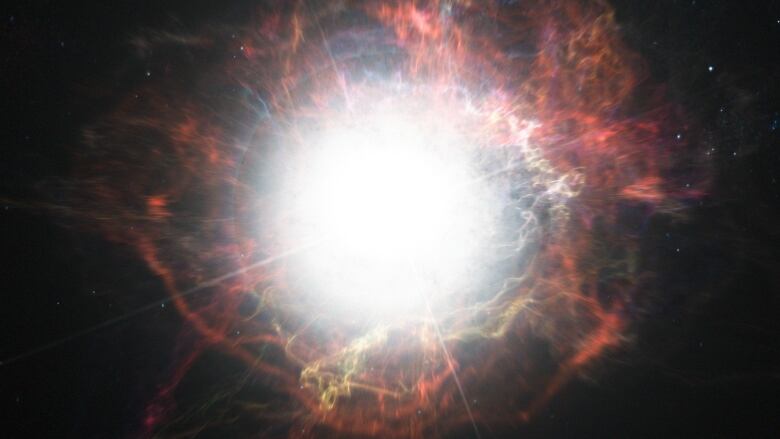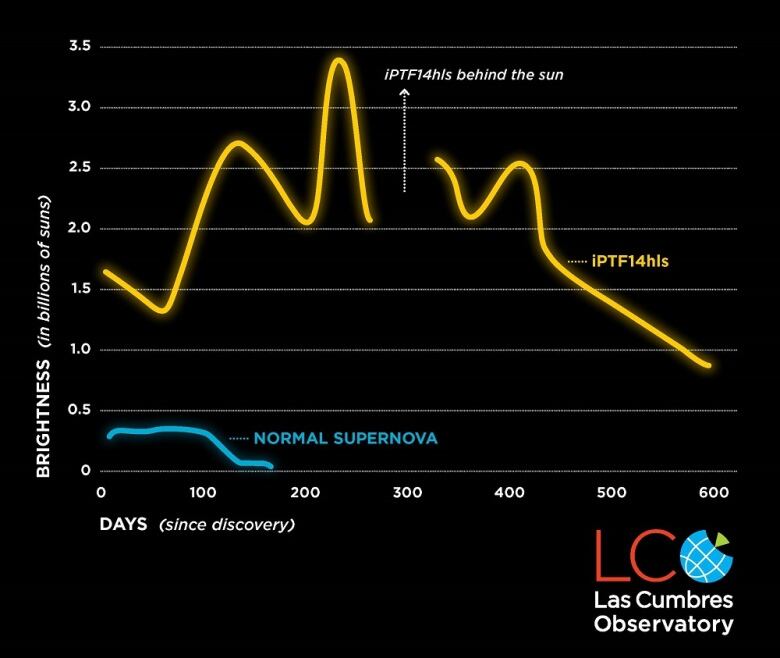Astronomers discover strange 'Dr. Jekyll and Mr. Hyde' supernova
Stellar explosion unlike anything astronomers have ever seen

In a galaxy far, far away lies a puzzling star, one that seems to be dying multiple deaths, leaving astronomers to rethink the way these beacons of the sky end their lives.
Stars can diein a few ways, but the most spectacular is as asupernova, an explosion that can outshine even its host galaxy. And while astronomers believe they have a relatively good understanding about how and why these stellar explosions occur, supernova iPTF14hlsdiscovered in 2014 just doesn't fit.
- Astronomers solve mystery of 'new star' spotted in 1437 AD'
- Telescope captures most detailed image of any star beyond the sun
- Astronomers see source of gravitational waves for 1st time
This star died as a Type II-P supernova in a galaxy 500 million light years away. These types of supernovas occurwhen a stareight to 15 times the massof our own sun exhausts its energy and explodes. Typically, they continueto shine for roughly 100 days. Over time they beginto fade.
But not iPTF14hls.Instead,it lasted 600 days.
In a new study published inNature, the team of international researchers discuss what could possibly account for the extremely long brightening period.
But nothing fit.
The mystery deepens
One method of studying stars is by analyzing their spectrum, where visible light is separated into its various colours. This can provide a wealthof information about a star, including data on its composition.
Initially, it looked like a run-of-the-mill supernova. But when lead author of the studyIairArcavi, from thedepartment of physicsat the University of California,took another look,he was confounded.
"I was really, really not expecting what we saw," he told CBCNews."What we saw was the spectrum of the most typical supernova observed. They always get bright for 100 days; this one didn't do that. It got faint and then bright," he said.
Four months after the initial brightening, it still only looked like a supernova that was just one month old.
"Six hundreddays later, the spectrum looked like that of a 60-day-old supernova," Arcavi said. "It was evolving, just in slow motion."

There seemed to be no rhyme or reason to it. It was like it just kept exploding over and over again.
As well, as supernovae expand and the shells of gas areblown off, astronomers normally see slower-moving material, but that didn't happen either.
And then came the temperature. If something expands but keeps the same brightness, it should cool. But once again iPTF14hlswould have none of that:it remained at the same temperature.
The researchers ruled out all the possible explanations.There was one final possibility: something called a pulsational pair instability supernova.
In this kind of stellar death, a star that has about 105 solar masses (one solar mass is equal to the mass of our sun) dies in an explosion, but instabilities produce several outbursts over an extended period of time, which would fit with iPTF14hls.
But again, it wasn't so simple.
Archival data suggests that there was an explosion in the exact same location in 1954, more than 60 years ago.

But a subsequent imageof the galaxy in 1993 showed no sign of the supernova.
While it's not entirely certain that it is the same star exploding, Arcavi said that there's just a one- to five-per-cent chance that it was a different star.
'Incredibly puzzling'
But the pulsationalpair instability model isn't a 100- per-cent fit, either.
"Apulsationalpair could give outbursts at very different time scales could be years, could be decades," he said. "But it predicts that the star should lose all of hydrogen in the first explosion. And we still see a lot of hydrogen in the 2014 one ... which the model can't really explain."
And there's more.
"The other problem is the energy we deduced for the explosion that happened now in 2014, is so high, it's more than all the total energy predicted by that model for all the explosions together,"Arcavisaid."So, that's a problem."

"It's crazy," said Maria Droutof the University of Toronto's Dunlap Institute for Astronomy and Astrophysics. Though not involved with the study, Drout most recently was part of the team that was thefirst to image the source of a gravitational wave earlier this year."It's incredibly puzzling."
"I don't think this changes the picture for your plain old vanilla Type II-Psupernovae. But it points out a new and unusual way that massive stars can explode or die," she said.
Arcavi said the ability to monitor the sky continuously something that wasn't possible in the past helped them discover this strange supernova.
"It begs the question: how many have we missed in the past?" he said.
- Discovery of 'monster' planet surprises astronomers
- Canadian astronomer spots 'visitor' from beyond our solar system
For Nick Konidaris, a co-author and an one of the inventors of the SEDMachine, a tool that allows telescopes to image the sky much faster than conventional methods,the discovery is what he always hoped would be the result.
"When we started designing and conceiving this SED Machine instrument, the thing we were really hoping for was this kind of discovery," he told CBCNews. "Where it was something new and exotic and could teach us something new about our universe."
And it worked.
Arcaviis excited to continue monitoring the strange star. As to whether or not it could brighten again, he says, "I'm not making any bets."
He's also looking forward to discovering if astronomers will produce new models and thus a new category for this type of supernova.
"It has these two aspects, a Dr. Jekyll and Mr. Hyde supernova that on the one hand is so weird and unpredictable, and on the other hand just has this textbook vanilla supernova spectrum, and we really don't know how to reconcile those two sides of it."












_(720p).jpg)


 OFFICIAL HD MUSIC VIDEO.jpg)
.jpg)



























































































